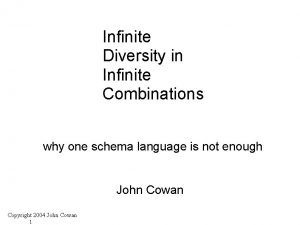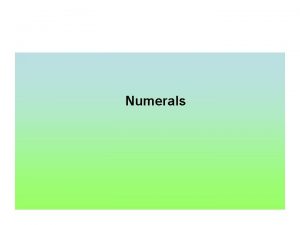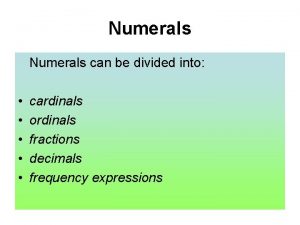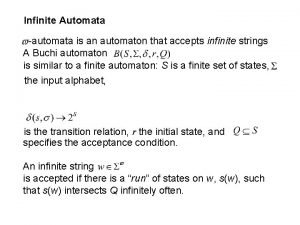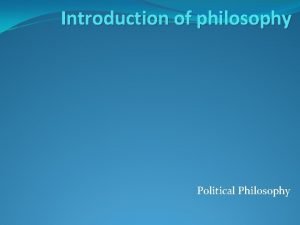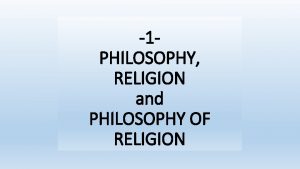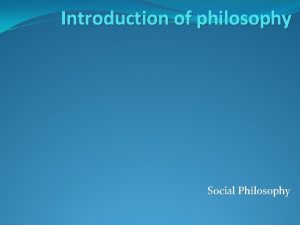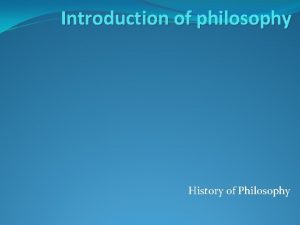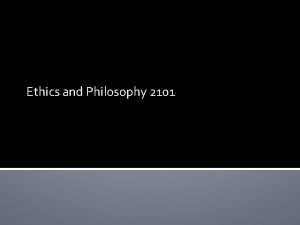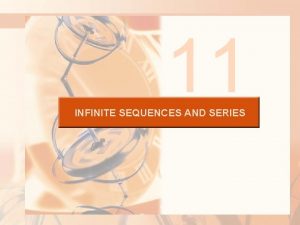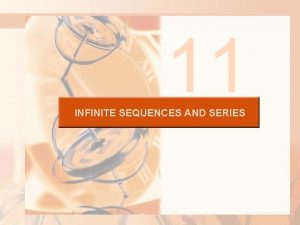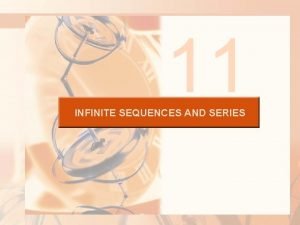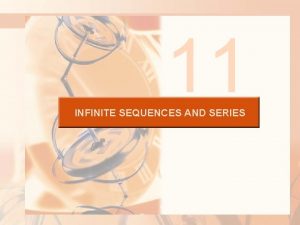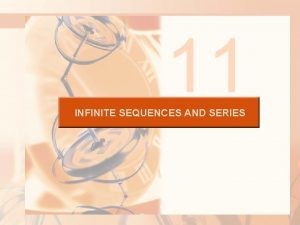Lecture 4 Infinite Cardinals Some Philosophy What is















- Slides: 15

Lecture 4 Infinite Cardinals

Some Philosophy: What is “ 2”? n Definition 1: 2 = 1+1. This actually needs the definition of “ 1” and the definition of the “+” operation. n Definition 2: Start with the concept of “two apples”, and remove all aspects of a single apple, e. g. redness, taste, etc. . You’ll be left with the number “ 2”. This definition is a bit problematic. n Definition 3: 2 = The class of all sets of size 2 (this is indeed a very large class) n Definition 4: 2 = {0, 1}, where 1 = {0} and 0 = {}. Note: 2 is a particular set of size 2.

Some History: What is “n”? n Historically, people could not count beyond some (relatively small) finite number, e. g. 10. n A (large) number “n” did not have a name, but people could access it by having a bag with n stones. n If a shepherd wants to make sure the number of sheep was n, he matches the sheep with the stones. n Thus, two sets have the same size if there is a bijection (one-to-one correspondence) between the elements of the sets. .

Some Definitions n The size of a set A is less than or equal to that of B, written A B iff there is an injective (oneto-one) function f: A B. n The size of a set A equals the size of the set B, written A B iff there is a bijective (one-to-one and onto) function f: A B. n We say that the set A is equipotent (or equinumerous) with B. n Note: If A is finite and has n elements, we can take the size of A = n. However, the size of an infinite set A is yet to be defined.

Some Simple Facts about n Obviously: A B. n The relation on sets is: Reflexive, i. e. for all sets A, A A. n Symmetric, i. e. for all sets A and B; A B B A. n Transitive, i. e. for all sets A, B and C; (A B and B C) A C. n The above properties are easy to prove. n Thus, is an equivalence relation on the class of all sets. n

Some Simple Facts about n The relation on sets is: Reflexive, i. e. for all sets A, A A. n Transitive, i. e. for all sets A, B and C; (A B and B C) A C. n Antisymmetric, i. e. for all sets A, B; (A B and B A) A B. n The first two properties are easy to prove, the third constitutes an important theorem… n

Cantor–Bernstein–Schroeder Theorem: n For all sets A and B; (A B and B A) A B. n Proof Outline: We have two injective functions f : A B and g : B A. We use these to construct a bijection h : A B. n The idea is to find a suitable subset C A, such that n (see http: //en. wikipedia. org/wiki/Cantor%E 2%80%93 Bernstein%E 2%80%93 Schroeder_theorem )

The following infinite sets are countably infinite (i. e. equipotent with N): n The set of even numbers n The set of prime numbers (or in general any infinite subset of N) n The set of rational numbers n The set of algebraic numbers (see n The set of computable reals (see n The set computer programs n The set of computer files http: //en. wikipedia. org/wiki/Algebraic_numbers http: //en. wikipedia. org/wiki/Computable_number ) )

Is every infinite set equipotent with N? n Answer: No! the set of reals R is larger than N. n Proof: Clearly N R means that there is a bijection f: N R, i. e. a listing of all reals of the form x 1, x 2, x 3, …. n We can then construct a real number y distinct from any infinite list of real numbers by letting: the ith digit of y the ith digit of xi

Picture Change all digits of the diagonal. 4 8 2 0 8 2 1 9 0 …. 7 0 7 3 6 9 6 3 9 …. 1 9 6 3 2 9 4 9 2 …. 0 7 4 9 3 8 9 5 1 …. 9 3 2 8 9 4 2 9 0 …. 4 6 8 5 3 2 8 0 0 …. 3 6 8 0 5 6 2 1 8 …. 7 5 3 7 8 0 8 1 3 …. 0 8 7 4 2 8 6 8 0 …. . . … … … … …

Picture to get the number: . 517003321…. 5 8 2 0 8 2 1 9 0 …. 7 1 7 3 6 9 6 3 9 …. 1 9 7 3 2 9 4 9 2 …. 0 7 4 0 3 8 9 5 1 …. 9 3 2 8 0 4 2 9 0 …. 4 6 8 5 3 3 8 0 0 …. 3 6 8 0 5 6 3 1 8 …. 7 5 3 7 8 0 8 2 3 …. 0 8 7 4 2 8 6 8 1 …. . . … … … … …

In general: Cantor’s Theorem n For every set A, its power set defined by n n P(A) = {X: X A} is larger than A. Proof: Clearly A P(A). If A P(A) , then there is a bijection f: A P(A). However, the subset B of A defined by: B = {a A: a f(a)} is not covered by f. If it were, i. e. B = f(a), for some a, then: a B a f(a) a B, a contradiction.

The Continuum Hypothesis We have infinitely many infinities. We call these א 0, א 1, א 2, … (the alephs) These are the infinite cardinal numbers א 0 (called aleph_0) denotes the size of N. We say: |N| = א 0 Question: Is |R| = א 1? (This is the so-called Continuum Hypothesis) n Answer: Our Mathematics is too weak to decide this question (assuming it’s consistent)! n n n

Cardinal Arithmetic n n n n Definition: Let |A| = , and |B| = . We define: + = |A B| (if they are disjoint) = |A B| = |BA|, where BA is the set of all functions from B to A. Note: These definition generalize the arithmetic of natural numbers. Facts: If one of and is infinite, then: + = = max{ , } If , then = 2 >

Thank you for listening. Wafik
 Infinite diversity in infinite combinations
Infinite diversity in infinite combinations Numerals cardinals
Numerals cardinals 5 cardinal signs of inflammation
5 cardinal signs of inflammation Numerals cardinals
Numerals cardinals 01:640:244 lecture notes - lecture 15: plat, idah, farad
01:640:244 lecture notes - lecture 15: plat, idah, farad Is ice cream countable or uncountable
Is ice cream countable or uncountable Some may trust in horses
Some may trust in horses Contact forces
Contact forces Sometimes you win some sometimes you lose some
Sometimes you win some sometimes you lose some Fire and ice diamante poem
Fire and ice diamante poem They say it only takes a little faith to move a mountain
They say it only takes a little faith to move a mountain Some say the world will end in fire some say in ice
Some say the world will end in fire some say in ice Lths infinite campus
Lths infinite campus Infinite campus mtsd
Infinite campus mtsd Ludovico bonfiglio
Ludovico bonfiglio Temporal logic
Temporal logic
